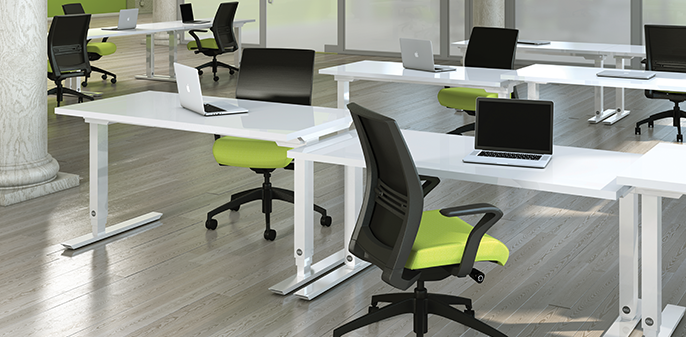Blog
How Do You Sit in an Ergonomic Chair?
Ergonomic chairs and office furniture are designed to be customizable. A properly adjusted ergonomic chair should help you maintain correct posture. The chair should accommodate your physical size and support your body so that you can sit and work comfortably. Good, supportive furniture helps to prevent long-term repetitive stress injuries at work.
If you can only afford one ergonomic piece of office furniture, the chair is ideal. Ergonomic office furniture is adjustable, and chairs typically allow you to set the following attributes to fit your needs:
- Low back support
- Seat height and tilt
- Arm height or remove arms
- Back height and tilt
- And more
Goals for Ergonomic Office Chair Adjustments
Here are a few conventions you should follow when you select and adjust your ergonomic chair. These recommendations help you position your body properly to maintain health while increasing your stamina and energy level at work:
- Sit with your hips pushed back as far as possible in your ergonomic chair.
- Set your seat height so feet are flat on the floor or use a footrest.
- Adjust seat tilt to avoid pressure on the back of the thighs or knees. A seat with front edge curved toward the floor is helpful. Check that your upper legs are parallel to the floor, or just slightly lower than hip level when seated.
- Set the chair’s back to a slightly reclined angle of about 110 degrees.
- Ensure the lower and upper back are supported. The lower seat back should curve toward your back slightly. Use a small pillow or backrest, or adjust the chair’s lumbar support, if included.
- Adjust armrests so that your shoulders are relaxed and forearms are at about a 90-degree angle, roughly parallel to the floor and just above your keyboard. If this is not possible, remove armrests, adjust desk height, and/or get a keyboard tray.
In addition to the adjustments, look for these office chair features:
- Easy-to-use controls, reachable from the seated position.
- Breathable fabric, especially on the seat.
- Swivel capability.
- Stable chair base. Five-point support is ideal.
- Casters/wheels with good traction that move well (and predictably) on your office flooring or carpet.
Arranging the Rest of Your Workspace Ergonomically
- The top of your computer screen should be 2-3 inches above your seated eye level. If using a laptop at your desk, use risers to bring the laptop to proper screen height. Use an external keyboard, placed directly on your desktop or keyboard tray, for proper, relaxed, shoulder/arm position.
- Position your screen to avoid glare and/or adjust nearby window blinds. You can also add a desk lamp/task light to diminish office lighting glare.
- Use a headset and speakerphone to avoid cradling a handset/receiver on your shoulder or over-reaching to answer a desk phone. If you have a desk phone, place it within easy arm’s reach of where you’re sitting.
The Healthy Way to Work with Your New Ergonomic Seating
Staying in one position too long (even with ergonomic office furniture) can make you vulnerable to physical pain and health issues over time. Be sure to alternate periods of standing, sitting, and walking. A standing desk or sit-stand desk can help you work in a variety of positions throughout the day. You can also set an alarm on your phone/computer, reminding you to take a 2-minute stretch break every half hour, while seated or standing next to your chair. Change from sitting to standing, and take short walks during your workday.
For more office furniture tips or to shop for ergonomic chairs, contact the MD and DC area office furnishing experts at PVI online, or call (301) 694-7162 today.


